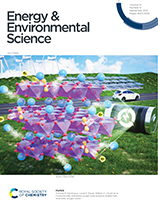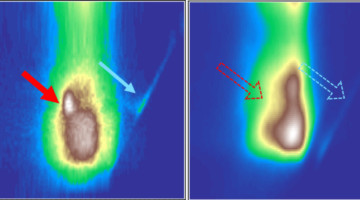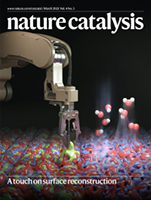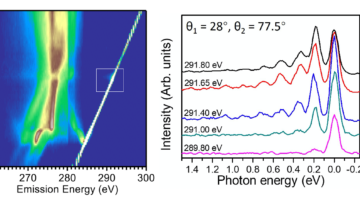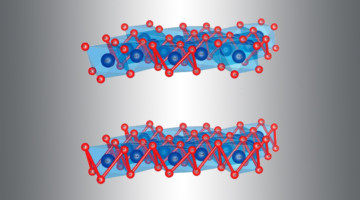We investigate oxygen redox in layered Na2−xMn3O7, a positive electrode material with ordered Mn vacancies. Our results establish a complete picture of redox energetics by highlighting the role of coulombic interactions across several atomic distances and suggest avenues to stabilize highly oxidized oxygen for applications in energy storage and beyond. Read more »
ALS Work Using RIXS
Resonant inelastic x-ray scattering (RIXS) is a photon-in/photon-out spectroscopy where both the energy and momentum of the scattered photons could be measured. A full-energy-range mapping of RIXS (mRIXS) is collected by sweeping the incident x-ray photon energy across the absorption edge of interest, and the inelastically scattered photon energy is detected by a spectrometer. Critical RIXS features often correspond to various low-energy charge, spin, orbital, and lattice excitations. At the ALS, an iRIXS endstation has been developed for high-efficiency mRIXS experiments.
X-Ray Study Recasts Role of Battery Material from Cathode to Catalyst
Researchers used the ALS to learn about a lithium-rich battery material that has been the subject of much study for its potential to extend the range of electric vehicles and the operation of electronic devices. Through a fundamental spectroscopic study, they not only clarified the reaction mechanism of this material, but also found a conceptually different use of it as a catalyst. Read more »
Study Shines New Light on Li-Battery Cathode Materials
Researchers clarified key reaction mechanisms in a Li-battery cathode material, revealing its surprising utility as a catalyst for next-gen batteries. The work refutes widely held ideas about reversible reactions in a highly debated material for Li-based batteries and expands the range of materials suitable for use in high-power batteries and fuel cells. Read more »![]()
![]()
Redirecting dynamic surface restructuring of a layered transition metal oxide catalyst for superior water oxidation
Electrocatalysts, particularly those for water oxidation, often experience substantial or at least partial reconstruction. Here, Wang et al. are able to control surface reconstruction using a cationic redox-tuning method on layered LiCoO2–xClx catalysts for the oxygen evolution reaction. The resulting optimized catalyst exhibits excellent electrocatalytic performance in alkaline electrolyte. Read more »
Detecting Phonon Overtones in Correlated Materials
Resonant inelastic x-ray scattering (RIXS) has recently been shown to be a promising technique for studying electron–phonon coupling in correlated materials. When a photoexcited electron interacts with phonons during decay, it shows up in the RIXS spectra as clear phonon overtones: higher-order excitations that appear as ripples in intensity. Read more »
Seeing ‘Under the Hood’ in Batteries
To push battery performance, researchers want to learn how the individual ingredients of battery materials behave beneath the surface. But many techniques only scratch the surface of what’s at work inside batteries. A high-sensitivity x-ray technique is attracting a growing group of scientists because it provides a deeper, more precise dive into battery chemistry. Read more »
Full Energy Range Resonant Inelastic X-ray Scattering of O2 and CO2: Direct Comparison with Oxygen Redox State in Batteries
The evolving oxygen state plays key roles in the performance and stability of high-energy batteries involving oxygen redox reactions. Comparison of the mRIXS profiles of four different oxygen states reveals that oxygen redox states in batteries have distinct widths and positions along the excitation energy. Read more »
How a New Electrocatalyst Enables Ultrafast Reactions
With key data from the ALS, researchers discovered how a new, low-cost electrocatalyst enables an important oxygen reaction to proceed at an ultrafast rate. The work provides rational guidance for the development of better electrocatalysts for applications such as hydrogen-fuel production and long-range batteries for electric vehicles. Read more »![]()
![]()
Fingerprint Oxygen Redox Reactions in Batteries through High-Efficiency Mapping of Resonant Inelastic X-ray Scattering
We provide a comprehensive analysis and an explicit interpretation of the five evolving components of O-K mRIXS of the typical battery electrode that involves lattice oxygen redox reactions upon cycling. This work is the first benchmark for a complete assignment of all the important mRIXS features collected from battery materials, and thus delivers guidelines for future studies of oxygen redox reactions. Read more »
Reversible Lattice-Oxygen Reactions in Batteries
Researchers quantified a strong, beneficial, and reversible (over hundreds of cycles) chemical reaction involving oxygen ions in the crystal lattice of battery electrode materials. The results open up new ways to explore how to pack more energy into batteries with electrodes made out of low-cost, common materials. Read more »![]()
![]()
